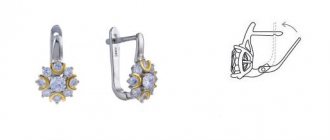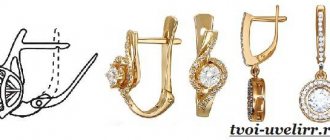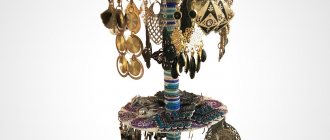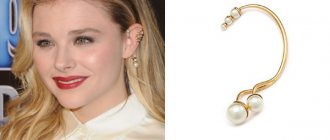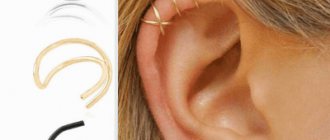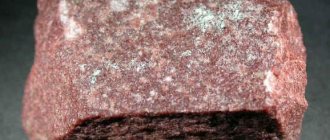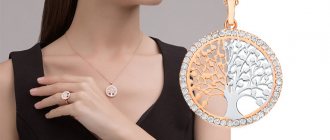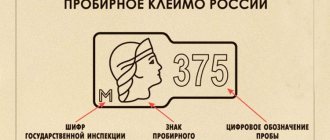I think that for many people the topic of earrings, or rather locks for your ears, is very important and relevant. Why is this topic relevant?
Because it is the locks on earrings that often become the reason for refusal to buy, wear, and, worst of all, blackening and allergies on the ears. Let's first understand the name of the locks, why allergies occur, and below you will see examples of the most common locks.
It is correct to call clasps for earrings earrings. Perhaps not everyone knows this. But when the master pronounces this word, then most likely you are at a loss: “What is this”? Now you know what earrings are.
What is the difference between earrings without a lock?
This is the most popular group of earring mounts. They are small hooks. The finished earrings are very easy to put on, since the fasteners simply need to be threaded through the hole in the ear. The fastening is made of thin metal, and under its weight the decorative part of the earring takes the correct position.
If the decorative surface of the product is heavy, the hook may fit more tightly to the ear or deviate. To make the earring wider, bend the hook slightly. To do this, you do not need to use special tools, the metal is very thin and light, it bends easily with your hands.
Hook-shaped hooks can be used by professional craftsmen or novice needlewomen. There are a lot of options for making such accessories: some options are decorated with rhinestones, springs or Swarovski beads, curly hooks or decorative plugs.
When purchasing earrings, it is necessary to take into account the density of the metal. The products are very thin, due to which they are simply threaded into the hole of the ear. If the products have large and massive decor, then the hooks can create discomfort and unpleasantly cut the hole of the lobe.
Earrings without additional fasteners and clamps are very easy to lose. If they are easy to remove, then they are just as easy to lose. To ensure that customers enjoy their purchase for a long time, manufacturers suggest using silicone plugs.
Earrings for earrings: what are they and what types of earrings are there?
Earrings are jewelry accessories used in the manufacture of earrings. Their invention actually gave rise to the earrings themselves as jewelry. True, there are earrings in which they are not used: for example, stud earrings or clip-on earrings.
The ancient Egyptians began making them in the form we are accustomed to. In Egyptian museums you can see earrings dating back to the second millennium BC. They were discovered during excavations of the tomb of Pharaoh Tutankhamun. That is, these works of ancient jewelry are more than three thousand years old. Near the ruler's sarcophagus, earrings in the shape of flying birds, very reminiscent of ducks, were found. Their raised wings formed a circle, inside of which is the bird's head, made of turquoise. Pendants made of precious minerals were used to depict bird tails. At the top above this entire composition there is a shvenza. It does not contain decorative elements, since its role is purely functional. And now we will tell you more about this.
What is Schwenza?
This term refers to the base of the earrings, which are inserted into the earlobe and secured in it with a loop. Actually, we can say that this loop itself is a shvenza. Just don’t confuse it with a lock, since even if it is present on the hook, it is part of its design, and not an independent element. In addition, there are earrings that do not have locks. They are usually placed on lightweight, inexpensive earrings. Such models are easy to use and budget-friendly. Products made from precious alloys or using precious stones do not have earrings that do not have locks, in order to reduce the likelihood of losing jewelry.
Since the earrings support the entire weight of the earrings, they must be strong. That's why they are made of metal. As we have already said, they may not have a lock, but they always contain structural elements for attaching decorative parts of the decoration.
So, pendants usually cling to a loop located at the bottom of the earrings. And there are recesses and platforms for attaching beads, stones or pearls. Sometimes the pebbles are grasped using special metal claws. This method of fastening is called a clamp. Another way is to glue the beads to the platform, for example with epoxy resin.
When decorating earrings in the form of rings, the decor is attached around the earrings, and is also strung directly onto it. We will tell you more about the types of bases for making earrings later.
Types of shwenz
This fittings have several classifications. Most often they are divided by structure.
- If the earrings have a lock, they are distinguished by the type of fastening. So, for example, in an English lock, a straight rod fits into an arched foot. There is a notch on the rod that hooks onto a spacer inside the tab.
- And in the French lock, the rod is replaced by an arched loop, which goes down to the edge of the earlobe, where it clings to a hook located at the other end of the ear hook
- There is also an Italian lock, which is generally similar to the English one, only the thread on the rod or inside the hole of the bow allows you to adjust the base of the earring in accordance with the thickness of the earlobe. An English castle does not have this opportunity. The bases in ring-shaped earrings are equipped with internal type locks, where the rod enters the bow on the back surface of the earlobe.
- Generally speaking, most of the hooks are variants of opening rings and loops of various shapes. And only studs are an exception, in which the earrings look like a straight rod. Instead of a tab, loop or ring, a limiter is used, which fixes the rod with a spacer or is screwed onto it in the form of a nut. Therefore, carnations are often carved.
- Ear hooks that do not have a lock are often used. They usually have a curved shape. This allows you to find a balance between the decorative part of the earring and the elements located behind the ear. Although sometimes the decor is also placed on the back side of the earlobes. This technique not only makes the jewelry more impressive, but also allows you to balance the earrings.
Classification by type of fastening of decorative elements
At the beginning of the article, we already mentioned the main types of platforms intended for attaching decorative elements. Now let's look at the differences in their structure in more detail.
Loops are divided into open and hidden. In the latter, the decorative fastenings are covered by the front plane of the earrings.
In addition, loops can be closed or open. In the second case, they are more like recesses or recesses located at the bottom of the hooks.
Also one of the varieties of an open loop is a clamp. It is used for inserts or beads that have holes in their upper part. They are attached to a loop that looks more like a lock. The metal arc is divided into a two-prong “fork”. Between these teeth there is a pin that fits into the hole of the bead. On its other side, the rod passes into another similar, but hollow rod.
Open areas to which decorations are attached to earrings can be flat or concave. The shape of the recesses can be with edges, for example, for rhinestones, or rounded, into which beads and cabochons fit well.
The presence of claw rods around the perimeter of the platform is typical for earrings intended for faceted stones. There are also platforms with sides. They are also convenient for attaching cabochons or semicircular beads. Their surface is smooth.
The platforms on the hooks are made solid or with holes. They allow you to decorate earrings with beads. And in order to cover the working rear surface of the platform, it is made double, the lower part in this case is solid, and the holes are located on the retractable part. However, simplified, single-level models are also produced. After fixing them with a thread of beads, they are sealed on the back side with leather or cloth.
You can find ear cords that do not have locks, as well as separate fastenings for decorative elements. In them, the earrings themselves act as fastenings: decorations are strung directly on them. We mean circular models. Let's bend, for example, a wire into a heart shape. Then we direct the wire upward, from the lower corner of the heart, leaving a gap and wrapping the wire in a ring. At the same time, we will not close it, since the end of the hook will be threaded through the earlobe. In this regard, the beads will be strung on the wire only up to the top turn of the arc.
The central part of circular earrings that do not have locks with fastenings can be different. They can be in the form of drop pendants, flowers or beads.
Classification by shape
The earrings also differ in their shape. There are models of the same diameter. There are samples in which the metal changes its thickness or width. You can see earrings that are held in the earlobes only due to the unevenness of their shape.
They can also be smooth or embossed: with linear grooves or rounded depressions, similar to cheese ones.
Classification by materials
Earrings are always made of metal. The alloy used and the proportional content of elements in its composition affects the quality, as well as the use of the wires.
Bases made of base metals are used in costume jewelry. Taking into account the contact of the earrings with the tissues of the earlobe, you need to choose hypoallergenic materials. Such a universal alloy is medical steel. As medical practice convincingly proves, the basics from it are not dangerous. Other alloys can cause allergic reactions, manifested by itching, suppuration or swelling of the earlobes.
Pewter alloy, which is based on tin, often causes allergies. Nickel and zinc also cause skin reactions. Copper is not very allergenic, and if reactions to its alloys occur, it is due to the presence of impurities in the composition. Since the same nickel and zinc, as well as lead, are added to copper in alloys.
Alloys in which copper, steel or titanium predominate are considered the most durable. And alloys that contain the most zinc and nickel are distinguished by great flexibility, comparable to pure gold. In order to give the gold jewelry alloy strength, copper, silver or palladium with nickel are added to it. It is important that palladium, like gold, is a hypoallergenic and precious metal.
Speaking about precious metals used in the manufacture of earrings, we must talk about silver. Most often, jewelers use 925 sterling silver. This means it contains 92.5% silver and the rest is copper. It makes the alloy stronger, similar to the case with gold alloys. However, even with the addition of 7.5% copper, the silver alloy remains quite flexible. Therefore, when an earring made of such an alloy has a complex shape, is made too thin or hollow, you should not risk sleeping in such earrings. It's better to take them off at night.
Silver is considered a budget option for jewelry. It is the cheapest among all noble alloys. A completely different matter is platinum metals, which, on the contrary, occupy leading positions in the price list.
The group of platinoids, in addition to palladium, includes octium and ruthenium. But jewelers almost never use them due to their fragility and refractoriness. Iridium also belongs to this group, but it is too hard to create jewelry. The earrings made from it are very durable and will last for centuries, but they are so difficult to make that the price of such jewelry is affordable to few people. Therefore, platinum is the most commonly used of this group of alloys. It wears well in earrings and has proven to be a fairly hard alloy even without adding impurities. Although, due to the high cost of platinum, compositions containing more than 70% of it are very rarely used in jewelry. But even if there is 50% of it in the alloy and the presence of base impurities in it, such earrings are considered platinum.
Materials for making earrings
Most earrings are made from metal alloys or iron. From a functional point of view, all materials are completely safe. But during operation, iron can become corroded, metal alloys can oxidize or lose their color.
To prevent products from losing their appearance, manufacturers coat the wires with a hypoallergenic composition. The lifespan of the fittings will depend on the quality of production. Typically it can range from one month to several years. Please note that this is not the timing of the link failure, but the rate of damage to the coating.
Elements that do not wear out and do not lose their appearance are made from medical steel or natural silver. These materials are completely safe and do not require additional coating. The only thing owners of costume jewelry face is tarnishing of the surface, but it can be cleaned and restored very quickly.
How about creating a decoration?
There is a widespread desire among our women to get involved in handicrafts and create a unique piece of jewelry just for themselves. Let it be a pendant made using some interesting technique (and there is a wide variety of these techniques now), or a bracelet in the making of which you have invested not only time and finances, but also a piece of your soul. Or maybe these will be unique earrings that all your friends will want to have. However, this pair of earrings will exist on the planet in a single, unique copy.
Are you excited about the idea of creating such a work, created by your own hands as a craftswoman? Great! First of all, we need earrings. When we decide on their type, then we can start creating earrings. You most likely do not know what it is and why you need it. Then let’s first study this issue and learn everything about earrings!
How to attach the earrings?
If the base of the jewelry will be decorated, then along with earrings you need to buy chains, crystals, beads, beads or, for example, Mallorca pearls. Regardless of the quality of the jewelry, there are two ways to fix the earrings - with glue or rings.
Some options are already decorated with rhinestones in production, others have settings for adding decor. The platforms for decorations are on nails or a French lock. The lock part can be decorated with rhinestones, crystals, and polymer products using glue.
If the jewelry is made from beads on a pin, then its tip is folded into a loop and fixed to the ring. If a connector, threads or feathers are used, then a ring is fixed to the earring. The open ring is held by the loop on the connector or end, penetrates the loop on the hook and is fixed with pliers.
Correct pronunciation
Masters and dictionaries claim that this word can be pronounced with emphasis on the first or last syllable. This pronunciation will still be correct. So what is earrings in jewelry? This element is used for earrings - we already understood this. But what is its purpose? What is earrings in earrings? Yes, you know, there are different types of earrings, for example, stud earrings or large hanging jewelry. And is it really possible that in all species there is this mysterious element with a name that is incomprehensible to a beginner?
Carnations
You already understand what earrings are, right? Such fasteners are also common and loved by many. The ear cords are easy to put on and can be removed from the ears without any problems. Studs, as they are otherwise called, are found not only in compact models of earrings, consisting of an earring and a small decoration on one of its sides. Studs can also hold fairly decent-sized dangling earrings.
The downside to wearing studs is their ability to “slip” if the earring is too massive and long. Therefore, when wearing a pair of earrings equipped with stud earrings, check the plugs located under the earlobe so as not to lose the earrings.
English
The English castle is also a type of shwenza. The good thing is that it fits easily into the ear and has a latch in its structure. Earrings with such a lock rarely get lost (although this does happen).
This clasp also has a minus. The fact is that each person’s earlobe has an individual structure and, accordingly, thickness. If the earring is thin, the earring will not hold the earring straight, and the earring will tilt forward under its own weight, which does not look very aesthetically pleasing. Thick earlobes may simply not fit into the piece of earrings intended for threading.
Ring
Another common fastener option. Actually the earring is called a “ring”. It looks like this: a ring with a thin pin attached to one side, which enters when put on and fastened to the other side of the ring.
This concludes today’s short review of earring earrings. Now you will know what shwenza is. Photos are provided only of those locks described in the article. However, jewelry masters and handmade jewelry manufacturers claim that there are many more different earrings.
French
French castle. This hook is essentially a slightly modified loop fastener. The hook also passes into the earlobe, but after threading, the upward-curved tip of the hook is additionally secured with a special fixing loop.
The downside is that over time, the loop holding the hook may bend or even break off.
How not to lose earrings with an English lock
Many jewelers in their work very often encounter a situation where it is necessary to make one earring from a pair due to the loss of the second.
It’s good when the products are symmetrical, but if not. Or they are decorated with rare natural stones; choosing a pair by size and color is a difficult task. It is impossible to describe the disappointment when the verdict is announced - it is impossible to make a copy, especially if it is a gift from a loved one. All these problems may not exist if you regularly monitor one important nuance.
As you know, gold and silver are very soft metals, especially high-grade alloys. Under the influence of its own weight, the hook unbends, which leads to spontaneous unfastening of the earring. This is especially true for massive jewelry. When closing the English lock, a characteristic clicking sound is heard. If it is missing, the hook should be slightly bent. How to do this correctly is described in the video below.
If you take into account everything stated in the article when purchasing, keep an eye on the earrings and regularly monitor the quality of the English clasp. It is guaranteed that you will never lose your favorite jewelry and will not be a regular customer of repair shops.
The strength of jewelry is a very important criterion when choosing, more about this in the article “Which weaving of a gold chain is the most reliable, photos and names.”
Sources
- https://999proba.com/anglijskaya-zastezhka-na-serezhkah-foto/
- https://1nerudnyi.ru/shvenzy-01/
- https://vseprokamni.ru/ukrasheniya/shvenza-chto-eto-takoe.html
- https://starsbead.com.ua/chto-takoe-shvenza/
- https://jewellerymag.ru/p/earrings-type/
- https://FashionApp.ru/yuvelirnye-ukrasheniya/vidy-zastezhek-na-serezhkax.html
- https://megabeads.ru/stories/shvenzyi-dlya-serejek-zachem-nujnyi-i-kakimi-byivayut
- https://www.syl.ru/article/348359/shvenza—chto-eto-takoe-vidyi-shvenz-materialyi-dlya-izgotovleniya
Studs
Or a more familiar option - carnations. The stud consists of a small pin and a platform. Pusset platforms are divided into decorated and simple (which are hidden under the base or decorated on top). A simple platform can be solid, flat, poured, in the form of a mesh, or it can have claws (special legs) for holding a small cone-shaped rhinestone. The decorated platform has a loop at the bottom for hanging additional decor and can be absolutely anything: it can be decorated with rhinestones or a convex pattern, have the shape of a solid ball, or have hooks for rhinestones and a loop for hanging decor at the same time.
To fix the stud on the ear, you will need separate fasteners, which can be metal, metal-plastic, metal-silicone and silicone.
Loop or hook
Schwenza loop - what is it? This is one of the very first fasteners that people learned to make. This method of attaching an earring is done by “hooking” the nose of the loop. It resembles a fishhook - only big. The hook is easy to insert and remove from the lobe. The decoration does not become heavier, and this makes wearing such a clasp very comfortable. Some girls believe that because of such a earring, an earring can easily be lost. They try not to purchase jewelry with this mount. Meanwhile, there is one trick that can save your favorite loop earrings: use silicone plugs - these are usually used to secure studs in the ear.
How to remove earrings with an English lock
Women usually have the most problems with the English lock - it is fixed so securely that it is not immediately clear how to remove it.
In general, you need to proceed with caution:
- Hold the pin between your fingers so that it does not move.
- Gently pick up the hook with your other hand and pull it up.
- When it moves slightly, pull it towards you.
It is important to catch the moment when the hook comes out of the groove and not pull it towards you until that moment.
If simply pulling up does not help, you should gently rock it from side to side.
The main thing is not to damage your ear in the process, don’t be nervous and don’t rush - and learning how to open an English lock on earrings won’t be that difficult.
